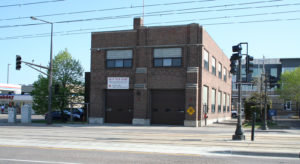By JANE MCCLURE
As more housing developed along University Ave., and vacant industrial buildings are repurposed, St. Paul city leaders have called for more public safety resources for the West Midway area. More than a decade later, that request is becoming a reality.
 St. Paul Fire Station 20 (photo right), 2179 University Ave.—which serves parts of the West Midway, Merriam Park and St. Anthony Park—will get an ambulance to meet growing demand for medical services. A fire engine will be placed at the station, too. That’s a result of a fire and medical services redeployment plan announced Jan. 22 by Mayor Melvin Carter III.
St. Paul Fire Station 20 (photo right), 2179 University Ave.—which serves parts of the West Midway, Merriam Park and St. Anthony Park—will get an ambulance to meet growing demand for medical services. A fire engine will be placed at the station, too. That’s a result of a fire and medical services redeployment plan announced Jan. 22 by Mayor Melvin Carter III.
The move triples the number of rigs at Station 20. Only a ladder truck is there now.
Station 20 is targeted for replacement in the next few years. It is in an area with substantial new housing development and redevelopment of older industrial buildings, spurred on in part by the 2014 opening of Green Line light rail. For several years city leaders have discussed the need for more fire and medical service in that area.
Last year a fire department labor-management committee proposed moving Engine 7 from Station 7 (1038 Ross Ave.) to Station 20. The committee also recommended retaining the three rescue squads that Coleman wanted to eliminate. Stations 7 and 20 are not equipped with ambulances, so the committee suggested moving a reserve ambulance to each location.
The move provides a faster medical response to area calls. The closest ambulances are currently at Station 23 (1926 Como Ave.) or Station 14 (111 Snelling Ave. N.)
Station 7 will keep its current ladder truck and get an ambulance.
The changes reallocate about $1.7 million but don’t create additional budget needs. The shift of equipment and personnel wins praise for providing ambulances for two fire stations that don’t have them. Demand for medical calls in the city far outpaces fire calls.
But the loss of a fire engine is a disappointment to East Side leaders, who contend they are losing needed fire protection. Carter announced the move not long after Ward Seven Council Member Jane Prince held a press conference protesting the loss of Engine 7.
Though she agreed with the need for more medical resources citywide, Prince opposed moving Engine 7, saying it is needed in the lower-income neighborhood around Station 7 which has many older wood frame houses.
Both the firefighters’ and fire supervisors’ unions support the changes, as does interim Fire Chief Butch Inks. “I appreciate the thoughtful approach that the St. Paul Fire Department, Local 21 and Local 3939 have engaged in with the development of this plan,” Carter said in a statement. “I’m confident that this plan will help meet our residents’ needs, both on the East Side and throughout all of St. Paul.”
The plan is being implemented now and doesn’t require St. Paul City Council approval because it doesn’t change the city’s 2018 budget and the $62 million allocated to the fire department. The council and former Mayor Chris Coleman agreed to lay over any reorganization decision until after Carter took office.
St. Paul Firefighters Local 21 stated support of the plan. “The consensus of this committee is to increase emergency medical services assets in the City of St. Paul. Without adding financial resources or personnel, this plan accomplishes that goal.”
The shifts also mean the St. Paul Fire Department can keep all three of its rescue squads. Each of the rescue squads has a specialty, along with assisting at fire and accident scenes. One is an emergency response and a second is chemical assessments at the scene of a leak or spill. The third rescue squad is dedicated to complicated rescues such as a cave-in. Coleman wanted to cut a rescue squad to meet the high demand for emergency medical services and add two super medic units. Super medic units allocate staff so that a station can operate a fire truck and ambulance at the same time. That means fire rigs are not tied up on medical runs and are available to respond to fire calls.
Coleman’s recommendations were tied to a Fire Department study carried out by an outside consultant, TriData. The study, which was released last July, found that fires account for less than five percent of the department’s emergency calls. The study called for changes in how medical services are delivered, noting the time and costs of sending out larger rigs.
Comments
No comments on this item Please log in to comment by clicking here